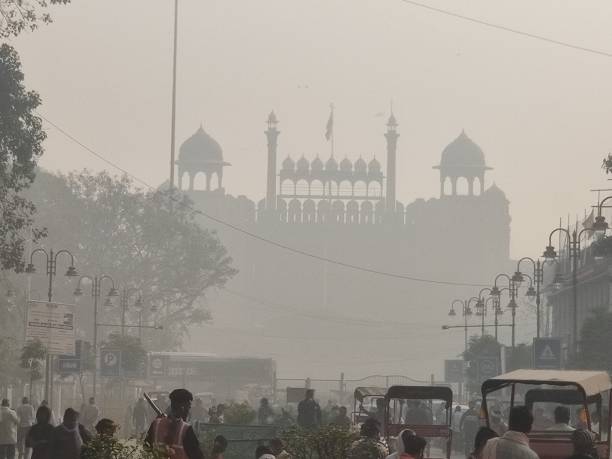India ranked as the 5th most polluted country in the world in 2024, according to the IQAir report, marking a slight improvement from 3rd place in 2023. Despite this, air pollution levels remain alarmingly high, with a PM2.5 concentration averaging 50.6 µg/m³, nearly 10 times the World Health Organization (WHO) guideline. Cities like Delhi continue to face dangerous pollution levels, contributing to 1.67 million deaths annually, 17.8% of total fatalities, underscoring an urgent need for action.
Unutilized Funds: A Governance Failure,
To combat this crisis, the Ministry of Finance allocated ₹858 crore for "Pollution Control Schemes" based on proposals from the Ministry of Environment, Forest and Climate Change (MoEFCC) and the Cabinet Committee on Economic Affairs (CCEA). However, less than 1% of these funds have been utilized due to pending approvals for the scheme’s continuation—a delay that raises questions about governance inefficiencies.
A recent report from the Standing Committee on Science and Technology, Environment, Forests, and Climate Change criticized the MoEFCC for failing to decide on the scheme’s continuation, despite India’s escalating air pollution crisis. The committee stated:
"At a time when the ministry is required to address the grave and critical challenge of deteriorating air quality, it has not been able to decide on the continuation of the concerned scheme, as a result of which not even 1% of the allocated funds have been utilized so far."
Policy Intent vs. Execution: A Recurring Gap,
The ‘Control of Pollution’ scheme, launched in 2018, was designed to monitor and mitigate air, water, and noise pollution across India. As part of the National Clean Air Programme (NCAP), it aims to reduce particulate pollution by 40% across 131 cities by 2026.
Despite its significance, the Union Environment Ministry has failed to utilize most of the ₹858 crore allocated for 2024-25, citing pending approvals for extending the scheme beyond 2025-26. This delay reflects a larger trend—despite the Ministry of Environment, Forest and Climate Change (MoEFCC) receiving ₹3,978.62 crore for the financial year, parliamentary reports reveal that only 54% of the overall budget was utilized, contradicting officials’ claims of 69% utilization.
More concerning is that less than 1% of the ₹858 crore meant specifically for pollution control has been used, despite India's escalating air pollution crisis. This gap between budget allocation and actual expenditure highlights governance inefficiencies and raises serious concerns over bureaucratic delays, transparency, and the effectiveness of environmental policymaking.
This underutilization has sparked sharp criticism, particularly as pollution levels continue to worsen nationwide. Despite officials’ claims of full fund utilization in previous years, the current stagnation highlights an urgent need for better fund management, accountability, and policy execution—before the crisis deepens further.
Historical Budget Allocation and Utilization,
This isn't the first time pollution control funds have been poorly utilized. Between 2019-20 and 2021-22, ₹400 crore was allocated to states for pollution control initiatives, yet only half of it was effectively used. Uttar Pradesh, for instance, received ₹77 crore, but only ₹30.57 crore was utilized, highlighting systemic inefficiencies that weaken pollution mitigation efforts.
This underutilization isn’t limited to state budgets—national allocations for pollution control have followed a similarly ineffective pattern over the years.
A review of past budgets allocated for the Control of Pollution scheme reveals a troubling trend:
| Financial Year| Allocated Budget (₹ Crore) | Utilization (%) | Remarks|
|-------------------|---------
| 2024-25 | 858 | <1% | Pending approval for scheme continuation |
| 2023-24 | 756 | ~54% | Delays in fund disbursement |
| 2022-23 | 690 | ~60% | Partial utilization due to administrative bottlenecks |
| 2021-22 | 620 | ~50% | Funds underutilized despite rising pollution levels |
| 2020-21 | 580 | ~48% | Slow implementation of pollution control measures |
The trend shows consistent underutilization of funds, with bureaucratic delays and pending approvals being major obstacles. Despite escalating pollution levels, the Control of Pollution scheme continues to face bureaucratic inefficiencies, raising concerns about poor fund management and weak policy execution.
Why Are Pollution Control Funds Not Utilized?,
The persistent underutilization of pollution control funds in India can be attributed to bureaucratic inefficiencies, administrative delays, and competing political and economic interests. Despite the dire need for effective pollution mitigation, several key factors continue to stall fund utilization.
One of the primary reasons is pending administrative approvals, as the ministry has yet to finalize the continuation of the Control of Pollution scheme beyond 2025-26, preventing allocated funds from being disbursed. This lack of urgency further exacerbates the issue, as decision-making remains sluggish despite worsening air pollution levels. Officials frequently cite procedural hurdles, delaying immediate action when timely interventions are needed.
Adding to the governance concerns, the Ministry of Environment, Forest and Climate Change (MoEFCC) has reportedly utilized only 54% of its total budget up to January 31, raising doubts about financial management and accountability. Even when funds are allocated, execution challenges—such as low survival rates in plantation drives—significantly reduce their impact.
Environmental policies also suffer from political prioritization, often taking a backseat to more electorally beneficial initiatives, particularly in election years. At the same time, state-center dynamics play a role in bureaucratic bottlenecks. Tensions between state governments (such as Delhi’s AAP-led administration) and the BJP-led central government may indirectly affect the urgency of fund approvals, leading to stalled implementation.
Beyond governance inefficiencies, industrial interests influence environmental policies through lobbying efforts, delaying stricter pollution control measures. Corporations often resist stricter regulations due to concerns over operational costs, further complicating fund utilization and policy execution.
These challenges are not exclusive to India—globally, environmental policies frequently clash with economic priorities and vested interests, shaping governance decisions in ways that hinder effective pollution mitigation. Addressing these inefficiencies requires stronger policy execution, independent audits, and stricter accountability mechanisms to ensure that allocated funds are utilized effectively and translated into real environmental impact.
Future Consequences of India's Pollution Crisis,
Without immediate intervention, India’s air pollution crisis will have devastating long-term consequences:
Life Expectancy: Pollution could reduce the life expectancy of 40% of Indians by over nine years.
Economic Costs: Businesses may lose $95 billion annually due to reduced workforce productivity and rising healthcare costs.
Agricultural Damage: Ground-level ozone pollution threatens crop yields, worsening food security.
Public Health Impact: Air pollution contributes to 1.67 million deaths annually, increasing cases of respiratory diseases, cardiovascular disorders, and cognitive decline, particularly affecting children and the elderly.
Conclusion: A Call for Action,
While India has made some progress under the National Clean Air Programme (NCAP), bureaucratic inefficiencies continue to stall essential pollution control measures. Without decisive action, fund mismanagement and governance failures will only deepen the crisis, leaving cities to choke under worsening air pollution.
To break this cycle, the government must prioritize fund utilization, enhance transparency, and enforce accountability to ensure environmental policies translate into real, measurable impact. However, policy reforms alone may not be enough—public pressure, citizen activism, and legal interventions could be the only forces capable of driving urgent action. If inefficiencies persist, India won’t just struggle to clear its air; it will suffocate under its own inaction.
references:
https://pwonlyias.com/current-affairs/control-of-pollution-scheme/
Not even 1% of allocated money used in 2024-25 for pollution control scheme










0 Comments